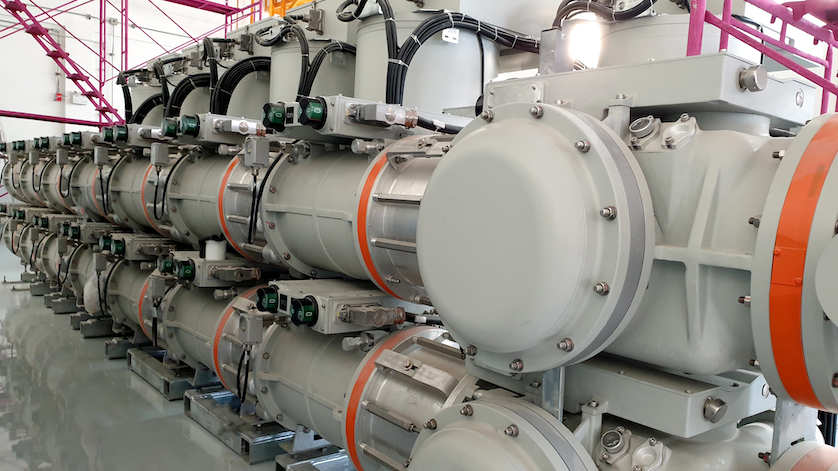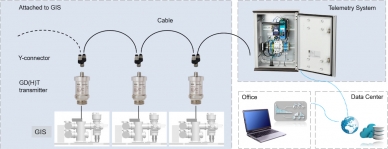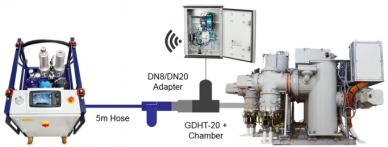
A major power provider in the Midwest was having issues with high humidity levels in its SF6 switchgear. WIKA implemented a cost-effective solution for keeping this insulating gas clean and dry, with significant potential savings.
By Leo Lopez, Rafael Derencio, Florian Vornberger
Sulfur hexafluoride (SF6) insulates medium- and high-voltage switchgears around the world. In its pure form, this non-toxic, inert gas helps the power transmission & distribution (T&D) industry operate more safely by extinguishing high-temperature arcs. With a much higher dielectric strength compared to other media, SF6 also allows gas-insulated equipment (GIE) to be compact.
However, as GIE ages, moisture enters the gas compartment to equalize with the dry SF6 gas. Water is the most powerful impurity in SF6 switchgear because it not only decreases insulation, but its hydrogen and oxygen atoms combine with sulfur and fluorine atoms to form toxic decomposition compounds. Many of the byproducts are corrosive, damaging switchgears and allowing SF6, a potent greenhouse gas, to escape into the atmosphere. Leak detection and gas analysis should be priorities for any user of this gas.
There are four main ways to protect T&D infrastructure and the planet from the effects of humid SF6 gas:
- Replace the gas-filled equipment that is allowing moisture to enter.
- Regularly replace the wet SF6 with new technical-grade gas.
- Regularly filter the humid gas and then put it back into the GIE.
- Retrofit new absorber kits inside gas compartments with low gas quality.
However, these methods are expensive and/or disruptive.
How to Deal with Wet SF6
One of the country’s top electrical power transmission companies was seeing high humidity levels in its SF6 gas-insulated switchgear (GIS). Except for that issue, the equipment was in good condition, so the company was eager for a more cost-effective solution than buying new GIS before the end of its planned lifecycle.
Replacing the wet SF6 is another option, albeit also expensive. First, technicians would have to take the equipment offline, which removes a layer of redundancy and affects the grid’s safety. Then they would need to evacuate the contaminated gas and replace it with technical grade SF6, which is not cheap: a 110 lb. (50 kg) cylinder of SF6 can cost more than $1,000. Recovering the humid SF6 gas, filtering it, and putting it back into GIE would save the company some money, but this process also involves significant downtime of the complete switchgear; replacing the saturated absorber material inside gas compartments shares the same downsides.
The company had tried to “dehydrate” the saturated compartment by filling it with a different gas that was very dry (e.g., N2), but was unhappy with the results. This method would have only a temporary effect on the dew point, and would still require the equipment to be taken out of service. Furthermore, the residual gas could contaminate the SF6 even more.
Trying to find a more cost-effective solution that would minimize the time equipment was offline, the company reached out to WIKA’s WEgrid Solutions division.
WIKA’s Solution: Gas monitoring + gas dehydration
After looking over the company’s operations, WEgrid experts proposed a smart two-part solution:
- Gas monitoring kit (GMK) with telemetry
- Gas dehydrating (GAD) system that dries SF6 without taking GIS offline
The GMK and GAD would be manually moved from compartment to compartment every two weeks or so to monitor gas conditions and dehydrate the SF6
Innovations in Purifying SF6 Gas
The “brains” of the GMK-20 are a set of GDHT-20 transmitters with Modbus® output. They attach to GIS to measure the density, humidity, temperature, and pressure of the gas; a telemetry system sends real-time information from the transmitter to the cloud and servers via a cellular data connection.
When the GMK detects that humidity in the gas has reached a certain level, the GAD-2000 goes to work. As it removes moisture from SF6, it also dehydrates the absorber material. What’s more, this gas dehydrator cart is also like a dialysis machine for GIS by filtering out harmful decomposition products such as hydrogen fluoride (HF), sulfur dioxide (SO2), thionyl fluoride (SOF2), sulfuryl fluoride (SO2F2), and sulfur tetrafluoride (SF4).
Best of all, the GAD-2000 can be used while the GIS is in service, thanks to a Safety Control System with several safety functions. This innovation precisely regulates the outtake of humid gas so that the equipment always has enough remaining insulation capacity. A small reservoir of dry, technical grade SF6 on the cart also replenishes the GIE to further improve the gas quality. This process is easy to use and risk-free.
The GAD-2000 allows for hands-off operations. After setting the parameters and starting the main dehydration process, the system will work automatically until the target humidity is reached. (The amount of time this takes will depend on several factors, including the GIE’s age, the working pressure range, and the compartment type and its absorbent materials. Very generally, dehydrating the gas in one compartment takes a week or so.) Throughout the cycle, the operator receives status information – via text messages to a cell phone – of how much the dehydration process has already been completed. At the end of the cycle, the operator receives a final notification before the GAD-2000 refills the compartment to its nominal pressure.
Results: Safety and savings for SF6 switchgear
The combination of GMK-20 and GAD-2000 has proven to be a winning solution for this transmission company’s issue of wet gas. Since the system’s implementation, this customer has successfully maintained safe operational conditions in its GIS at a fraction of the cost of other options. Moreover, the company estimates it will save over $50,000 a year in downtime alone. (Results will vary by facility size, equipment, and other factors.)
The usual lifetime for GIS is 30 to 35 years. Since such equipment is expensive, extending its lifetime by even a few more years means a company can realize tremendous savings. The earlier a T&D provider incorporates this system in its service activities, the fewer humidity-related SF6 failures their equipment will experience, and the longer their GIS will offer reliable and safe service for the electric grid.
With decades of experience in the T&D industry, WEgrid can find a solution for your SF6 challenges. Contact us with your questions and SF6 gas issues.
Products mentioned in this blog:




How it could be cost effective as now a days even a single GIS bay is having multiple chambers. Is it possible that single unit can serve complete GIS if yes how need your response
Hey Altaf,
Thank you for your comment. A product manager should be emailing you shortly with a response.